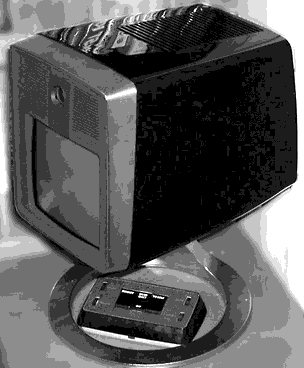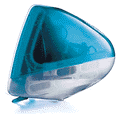1999 – Back in the 1960s, the videophone was the thing of the future. In the 1970s, we’d be able to see the people we were talking with, not just hear them.


AT&T Picturephone
It didn’t happen. At its peak, perhaps 500 people across the US used the AT&T Picturephone by 1975. Today we have touch-tone phones, call ID, line blocking, and more, but videophones simply haven’t become popular.
At the same time, the phone companies are concerned about losing business to the internet (especially long distance calls), just as postal authorities around the world are losing business to overnight couriers and email. The age of the internet phone is dawning – and, for some, it is already upon us.
Anyone with an internet connection, a speaker, a microphone, and the right software can converse with anyone else so equipped anywhere in the world. No long distance charges, unless it’s long distance to connect to your ISP.
The age of the webcam arrived a year or two back, propelled by the first commercial webcam, the Connectix QuickCam, launched in 1974. Today, it’s very easy to set up a webcam and have it automatically upload pictures to your site.
Combine the two, and you’ve got a videophone. Although video quality is nothing to get excited about using a 56k modem connection, that’s the bottom rung of internet connectivity today. With cable modems and various types of DSL set to take off in 2000, the bandwidth will be there.
All we need is the hardware.
You can do it yourself. Choose the USB camera that suits your needs. Use a microphone and speakers (or headphone) – or get one of those Jabra microphone/earphone thingies. Then find the right software to meld sound and video, find a friend, and make the connection.
 Or you can buy the iPhone (actual product name subject to trademark search and registration), which should be available sometime next year as Apple’s first internet appliance.
Or you can buy the iPhone (actual product name subject to trademark search and registration), which should be available sometime next year as Apple’s first internet appliance.
According to our sources, it will look a lot like a miniature iMac, but one with a 6″ color screen. You’ll be able to set it on your desk, on the counter in your kitchen, or mount it to a wall (using an optional bracket).
Unlike the iMac, the iPhone will have a tilt-and-swivel base – essential for not only letting you see who you’re talking to, but also so the internal camera can see you. The base can also be adapted for mounting the iPhone on a wall. All this will make it easy to point the camera elsewhere to show your friend Down Under what a Michigan winter looks like.
There will also be a microphone and speaker, but for privacy or better sound quality, you may want to use the Jabra earpiece that is expected to ship with the iPhone.
The iPhone will come equipped with a 10/100 ethernet port and an AirPort slot, making it easy to integrate with your current computer network. In fact, with the right software, you’ll even be able to use the iPhone as a webcam when you’re not using it as a videophone.
Apple will strongly suggest a fast internet connection, something beyond the ISDN and 56k lines that are common today.
And who will you talk to? Anyone on the internet!
Apple will make the iPhone client software available for free. It will run under any version of OS 8 or later. There will also be Windows and Linux versions available. And even if they don’t have a camera, they will be able to see you (or whatever you’re aiming the iPhone at). The software should support most webcams, though, so it should quickly become the norm for videophones.
Other rumors are that Apple will team up with AOL, making this part of AOL Instant Messenger 4.0.
The Hardware
Specs are pretty vague, but the iPhone won’t need a lot of horsepower. It will probably use a relatively slow G3 processor (under 300 MHz if available). It won’t need a lot of memory. What OS it has will be built into ROM and flash ROM. It won’t have a CD-ROM drive, a hard drive, a keyboard, or a mouse, although any of these can be connected via one of two USB ports.
Apple will resurrect some of its Newton technology. The iPhone will have a touch-sensitive surface you can use with a stylus (preferred) or finger (leaves fingerprints, so not really recommended). You’ll have pulldown menus for your most-used “phone numbers,” an onscreen dialing pad, and a USB phone pad for more conventional “dialing.” (Yes, the iPhone will also be able to use your regular phone lines for non-video calls.)
The Mac OS we know and love won’t be present – it will be OS X-based, but with a very stripped, customized version of the OS. Still, if you wanted to, it would probably be possible to boot from an external drive and run Mac applications (including games) within the limitations of memory and screen size.
Whether Apple will choose a 320 x 240 screen format or adopt the 512 x 384 resolution once used in LCs and Color Classics remains to be seen. Less resolution means less data to send, which is a benefit on limited bandwidth internet connections. (Video is limited to 16-bit capture and display, also to reduce bandwidth.) We suspect Apple will go with the lower resolution.
As for memory, with the OS and applications in ROM, it’s conceivable the iPhone will have less than 64 MB of RAM, making it impractical to use as a conventional computer. After all, Steve Jobs doesn’t want this cute little thing to steal iMac sales.
At an expected price of under US$300, that temptation would exist if Apple hadn’t deliberately made it impossible to install an internal hard drive. In fact, they’ve made it very difficult to open the case. (If it should break, it will have to go back to Apple for replacement.)
That said, we expect Mac lovers will find ways to open the case, boost memory, connect USB drives, and set the iPhone up as a miniMac in its own right.
It’ll sure look cute next to my big Mac’s 20″ screen.
– Anne Onymus
Keywords: #iphone #videophone
Short link: http://goo.gl/p6HtY3

